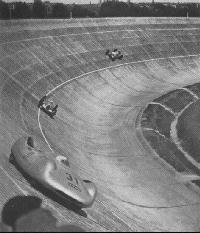Faster, higher, stronger
Author
- Leif Snellman
Date
- 8W August 1999 issue
Who?Bernd Rosemeyer, Ernst von Delius, Dick Seaman What?Auto Union 6.0L C-type streamliner special, Auto Union 6.0L C-type, Mercedes W125 Where?AVUS When?VI Internationales AVUS Rennen, 1937 |
 |
Why?
This picture could be called "Citius-Altius-Fortius", faster-higher-stronger. It represents the ultimate in pre-war motor racing, Rosemeyer at Avus 1937.
In 1936 the Olympic games were held in Berlin. The Nazi regime spared no efforts to make the games into a propaganda triumph and among other things built the first real Olympic village. There were also other big events in Berlin during that year that needed construction work such as the Berlin Motor Show that was to be held in the Grünewald district where Berlin's Grand Prix track Avus was situated. (The initials AVUS stand for Automobil Verkehrs und Übungs Strasse, which can be translated into something like "car traffic and practice street".
For the show the nearby fairground was extended with a new access road to be built. That meant that the old Avus North curve from 1921 had to go and the track had to be shortened. It also meant that there would be no GP race on the track in 1936. As a compensation to the organizers the track was given a new banked North curve for free.
Banked curves were nothing new in Europe of the 30s. Brooklands in England was banked, as was Monza in Italy and Montlhéry in France. However, as AVUS already was an extremely fast track - it consisted of two, some 9 km long, parallel straights connected by a 180 degree curve at each end - it meant that from now on the racing cars only had to go through one slow curve per 19.286 km lap. The new North curve was built with a surface of red bricks and had a banking of 43 degrees. With the track turning up into a low vertical wall with no other safety arrangements on its high side any driver that went off could expect a long airborne ride. It is therefore no wonder that the curve soon got the nickname "The wall of death".
The AVUS Grand Prix had for several years seen the use of streamlined race cars. In 1932 the young Manfred von Brauchitsch had driven to a sensational victory in his own Mercedes SSKL fitted with a cigar-shaped body and in 1933 Otto Merz lost his life in another streamlined SSKL when he lost control during a rainy practice session. The Avusrennen were raced as Formula Libre or free formula race instead of the current 750kg maximum just to admit the constructors to take advantage of the possibilities streamlined cars had. Both the leading German teams, Mercedes-Benz and Auto Union had been working hard on record braking cars during that time so it was natural for them to adopt the record car bodies for the Avus race. For the race Auto Union entered two normal Grand Prix cars and two specially built streamliners.
With no weight limit the streamliners incorporated such extras as internal jacks. They were not the easiest things for entering or leaving the cockpit. In fact the area round the cockpit had to be raised by a mechanism and then the driver had to crawl under it to leave the car. It took a personality to race such a monster and Auto Union had found the right man in Bernd Rosemeyer.
Like Gilles Villeneuve, Rosemeyer was one of those unique drivers who appear only once per driver generation, a man who has "the right stuff". A former motorcycle racer, Rosemeyer had never started in any kind of car race before his debut race in an Auto Union on this very track at the 1935 Avusrennen. From then on fame had come incredibly fast and as he now two years later entered his second race at Avus he did it as reigning European Champion. During practice Rosemeyer flew to an unofficial record with a 4:04.2 lap which meant an amazing speed of 284.31km/h. On the straights the cars could reach 380 km/h while the North curve could be taken with 180 km/h.
Mercedes driver Hermann Lang tells in his book that braking from 380 and going into the curve with the driver seeing the ground to the left and the air to the right felt more like airplane acrobatics than car racing. The race was held in two heats plus a final. While it's unnecessary to go through all steps of the race here (you can find a full race account here) it's fair to say it did not turn out to be Rosemeyer's day. He neither won his heat nor the final. In the heat Rosemeyer took an early lead followed by von Delius and Seaman. The heat then developed into a slipstream duel between Rosemeyer and Caracciola, a duel the Mercedes driver won. In the final Rosemeyer had to make an early stop for tyres and finished fourth while the race was won by Lang in a streamlined Mercedes.
However Rosemeyer did one significant thing that day. During the fight with Caracciola in the heat he did his last lap in 4:11.2. With an average 276.39 km/h (171.78 mph) that was the fastest racing lap of the pre-war era. As a matter of fact, no Formula 1 race has ever reached that lap speed so it remains the fastest lap ever done in Grand Prix racing. It was not until the early 70s such speeds were seen in the Indy 500.
